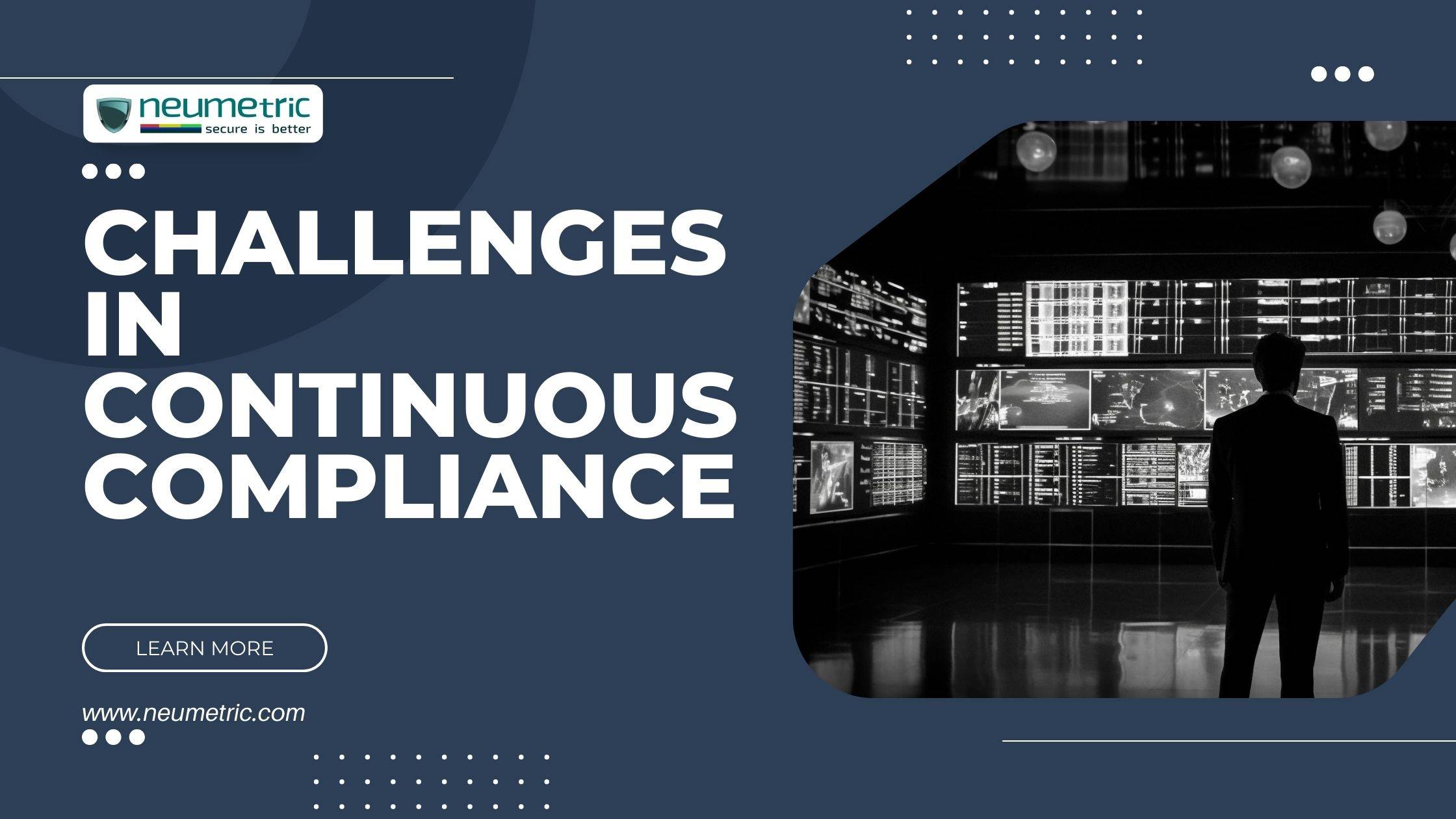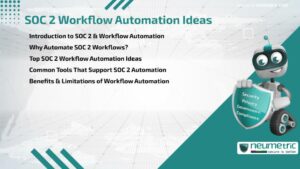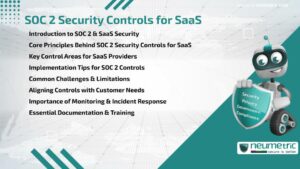Table of Contents
ToggleIntroduction
Continual Compliance is a technique in which organisations conform to legal obligations, industry standards & internal regulations on a continual & proactive basis. Continuous compliance, as opposed to traditional compliance procedures that include periodic audits, involves real-time monitoring, assessment & modifications to ensure ongoing adherence to multiple regulatory standards. The changing nature of the business landscape, as well as the increasing complexity of regulatory regimes, drive this proactive strategy.
Maintaining compliance in today’s business climate is more difficult than ever, thanks to rapid technological improvements, increased interconnection & an increasing number of regulatory obligations. Continuous compliance is critical for managing risks, securing sensitive data & building a security culture within organisations. It not only aids in the prevention of regulatory violations, but it also improves overall cybersecurity, fosters trust among stakeholders & contributes to the business’s long-term viability & success. As businesses expand, adopting continuous compliance becomes increasingly important for adjusting to changing regulatory landscapes & providing resilience in the face of rising threats.
Understanding Continuous Compliance
Continuous compliance is taking a proactive, continuing approach to meeting regulatory requirements & adhering to industry norms. Real-time monitoring, automation of compliance operations & a dynamic, adaptive reaction to changes in the regulatory landscape are among the basic ideas. Organisations want to lower the chance of noncompliance & improve overall risk management by incorporating compliance into daily operations.
Continuous compliance, as opposed to traditional compliance approaches, which frequently rely on periodic evaluations & audits, emphasises a more flexible & responsive process. Traditional approaches may leave organisations vulnerable to emerging threats due to compliance gaps between audits. Continuous compliance, on the other hand, uses technology & automation to give a more consistent & timely assessment of compliance status, lowering the possibility of lapses & improving total compliance.
The Evolution of Compliance Challenges
Compliance in business has evolved throughout time, from simple legislative obligations to more complicated & nuanced frameworks. Compliance, which was first focused on fundamental financial & operational norms, has expanded to meet a larger range of problems, including data protection, cybersecurity & ethical considerations. The historical viewpoint emphasises the importance of organisations adapting their compliance strategy to meet new issues.
Due to variables such as globalisation, rapid technical breakthroughs & growing interconnection, compliance concerns have gotten more complex in the digital era. Organisations today have to deal with a plethora of legislation from multiple jurisdictions, which necessitates a thorough understanding of international law. Furthermore, the digitisation of business processes creates new risks linked to data security & privacy, demanding a dynamic approach to compliance capable of efficiently addressing these growing complexities.
Key Components of Continuous Compliance
A. Real-time Monitoring & Assessment
Continuous compliance is based on real-time monitoring tools & technology that provide an up-to-the-minute, dynamic view of an organization’s compliance status. This enables for the quick detection of possible problems, allowing for prompt corrective action & lowering the likelihood of compliance gaps between assessments.
B. Automation in Compliance Processes
Automation helps to ensure continual compliance by automating common operations like data collection, processing & reporting. Automated compliance processes not only improve efficiency, but they also eliminate the possibility of human error, resulting in more consistent & dependable adherence to regulatory requirements.
C. Integration with Existing Systems
Continuous compliance must interact smoothly with an organization’s existing systems & operations in order to be effective. This integration guarantees that compliance is knit into the fabric of daily operations, reducing disruptions & establishing a more sustainable & adaptive compliance structure.
Common Challenges in Continuous Compliance
Rapid Technological Advancements
The ever-changing technology landscape makes maintaining compliance difficult. Organisations must constantly update their infrastructure to suit changing technology. This entails making certain that compliance procedures remain effective & compliant with the most recent advancements. The impact on compliance infrastructure is particularly severe, necessitating investments in systems capable of adapting to the rapid speed of technological development.
Another aspect of this challenge is keeping up with evolving security risks. Because cybersecurity dangers are dynamic, a continuous & flexible strategy to threat detection & response is required. Continuous compliance plans must include the most recent security measures to protect against emerging threats, with a focus on real-time monitoring & adaptive security standards.
Data Privacy & Protection
Navigating global regulatory frameworks is a huge difficulty for cross-border organisations. Diverse & sometimes conflicting data protection rules necessitate a unified approach to maintain compliance. This entails addressing regional differences in data protection legislation & implementing policies that adhere to various international standards, all while maintaining a consistent & worldwide approach to data privacy.
Maintaining compliance with data handling rules is also an ongoing challenge. To satisfy the needs of increasing data protection legislation, organisations must prioritise safe data storage, transfer & processing. To protect sensitive information, strong data protection mechanisms, such as encryption & access controls, must be implemented.
Organizational Resistance & Cultural Shifts
The implementation of continuous compliance may confront internal resistance. To overcome this resistance, good change management tactics, communication & education are required. Fostering a compliance-oriented culture is critical, emphasising the importance of compliance as a core component of the organization’s beliefs & operations rather than just a legislative duty.
Finally, the challenges of continual compliance highlight the importance of organisations being adaptive, technologically sophisticated & culturally aligned. To address these problems, a comprehensive approach combining technical solutions, international compliance techniques & a determined effort to embed compliance into organisational culture is required. Navigating these issues successfully positions organisations not just to meet legal requirements, but also to proactively manage risks & develop a resilient & secure operational environment.
Organizational Resistance & Cultural Shifts
A. Overcoming Resistance to Change
When it comes to achieving continuous compliance, one of the most typical roadblocks is organisational reluctance to change. Employees may be resistant to new processes, technologies, or techniques because they are afraid of the unknown, concerned about job security, or prefer familiar routines. To overcome this reluctance, strong change management tactics, clear communication & employee participation are required. Leaders must communicate the benefits of continuous compliance, as well as address concerns & include staff in the change process. Training & assistance can help employees adapt to new practices, resulting in a more positive reaction to the changes.
B. Fostering a Compliance-Oriented Culture
The effectiveness of continuous compliance programmes is dependent on the establishment of a compliance-oriented culture. This cultural transformation entails developing a mindset in which compliance is considered as an essential component of daily operations rather than a difficult task. Leadership is critical in setting the tone & expectations. Companies can foster a compliance culture by including it into staff training programmes, recognising & rewarding compliance initiatives & displaying a commitment to ethical business practices. Employees are more inclined to participate to & advocate continuous compliance initiatives when compliance becomes engrained in the organisational DNA.
Technology Solutions for Continuous Compliance
A. Role of AI & Machine Learning
Artificial Intelligence [AI] & Machine Learning [ML] can help with continual compliance. Organisations can use these technologies to automate regular compliance operations, analyse massive amounts of data in real time & spot trends or anomalies that may suggest possible compliance issues. AI & machine learning can improve risk prediction, streamline decision-making processes & minimise the manual effort involved with compliance monitoring. Organisations can establish a more efficient & accurate continuous compliance framework by employing these technologies.
B. Implementing Effective Cybersecurity Measures
Cybersecurity is inextricably linked to continual compliance & organisations require strong safeguards to secure sensitive data. This entails integrating modern cybersecurity technology & techniques that are compatible with the ever-changing nature of cyber threats. Intrusion detection systems, encryption techniques, multi-factor authentication & regular security audits are all effective approaches. Continuous vulnerability monitoring & fast response to emerging threats are critical components of a cybersecurity strategy that is linked with continuous compliance. Integrating cutting-edge cybersecurity measures ensures that organisations not only meet regulatory standards, but also have a resilient defence against developing cyber hazards.
Future Trends in Continuous Compliance
A. Anticipated Technological Advancements
The future of continuous compliance is inextricably linked to expected technology improvements. Several developments are predicted to affect the technological components of continuous compliance as organisations attempt to stay ahead in a fast expanding digital ecosystem. Artificial Intelligence [AI] & Machine Learning [ML] are set to play a larger role in improving real-time monitoring & predictive analytics. AI can analyse large information to find patterns & abnormalities, allowing organisations to handle possible compliance concerns before they worsen. Furthermore, technological developments in automation are expected to streamline & optimise compliance operations, decreasing manual labour & enhancing productivity.
Blockchain technology is another area of interest for continuous compliance. Its decentralized & immutable nature can enhance data integrity & traceability, contributing to transparent & auditable compliance records. Organizations may explore the use of smart contracts on blockchain to automate & enforce compliance agreements in a secure & verifiable manner.
B. Regulatory Developments Shaping the Compliance Landscape
Because of regulatory advances, the compliance landscape is projected to experience considerable changes. The implementation of more severe data protection legislation, motivated by an increased focus on consumer privacy & the handling of sensitive information, is one of the anticipated trends. Regulations may address the ethical use of developing technologies such as artificial intelligence, the Internet of Things [IoT] & biometrics as digital transformation & business models evolve.
As organisations face increasing pressure to align with sustainable & socially responsible practices, Environmental, Social & Governance [ESG] factors are likely to acquire importance in compliance frameworks. This could result in new compliance requirements for environmental impact, diversity & inclusion & ethical company activity.
Best Practices for Overcoming Continuous Compliance Challenges
A. Proactive Risk Management Strategies
Proactive risk management is critical for overcoming obstacles in continuous compliance. Organisations should undertake detailed risk assessments on a regular basis to detect potential compliance gaps & risks. Organisations can avoid regulatory infractions & improve overall resilience by anticipating & managing risks before they arise. This entails putting in place a solid risk management structure, which includes constant monitoring, threat intelligence & scenario planning.
B. Collaborative Approaches Within Organisations
Continuous compliance is a team endeavour that necessitates collaboration across several divisions within an organisation. Establishing excellent communication channels & fostering a collaborative culture ensures that multiple stakeholders, such as IT, legal, compliance & business units, collaborate effortlessly. This collaborative approach promotes the exchange of insights, best practices & knowledge, resulting in a holistic & integrated solution to ongoing compliance concerns. Regular compliance training & awareness campaigns can assist align teams with compliance goals & contribute to a cohesive organisational compliance approach.
Conclusion
The continuous compliance landscape is changing, offering organisations with both difficulties & possibilities. Several major trends are expected in the future, particularly in the areas of technology & regulatory developments.
Artificial Intelligence [AI] & Machine Learning [ML] stand out as revolutionary forces in determining the future of continuous compliance on the technology front. These technologies are likely to result in more sophisticated & proactive monitoring & analytics approaches. The power of AI to analyse enormous datasets in real-time, combined with the pattern recognition capabilities of machine learning, promises to revolutionise the identification & mitigation of compliance issues. Furthermore, blockchain technology appears to be a game changer, providing decentralised & immutable solutions for improving data integrity & traceability in compliance records.
Simultaneously, regulatory developments are expected to have a considerable impact on the compliance landscape. The prospect of stricter data protection legislation emphasises the growing need of protecting sensitive information in an increasingly digital society. Furthermore, as organisations embrace digital transformation, rules may change to address the ethical implications of emerging technologies, emphasising responsible behaviours in fields such as AI, IoT & biometrics. Environmental, Social & Governance [ESG] factors are on the rise, indicating a shift towards holistic compliance frameworks that include sustainability & social responsibility.
To navigate these future trends successfully, organizations must adopt best practices for overcoming continuous compliance challenges. Proactive risk management strategies, including regular risk assessments & scenario planning, are essential to identify & address potential compliance gaps. Collaboration within organizations is equally crucial, as different departments must work cohesively to ensure a unified & effective approach to compliance.
FAQ’s
- What is continuous compliance?
Continuous compliance is a proactive & ongoing approach to adhering to regulatory requirements & industry standards in real-time, ensuring a constant state of compliance.
- What role does technology play in continuous compliance?
Technology, including AI, ML & automation, plays a crucial role in continuous compliance by enabling real-time monitoring, predictive analytics & streamlined compliance processes.
- What challenges does continuous compliance face in the future?
Future challenges for continuous compliance include keeping pace with technological advancements, navigating global regulatory landscapes & addressing emerging issues such as data privacy & ESG considerations.





